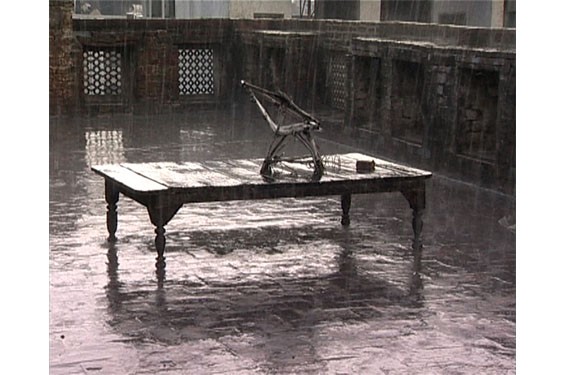Writing in the aftermath of World War II, the German philosopher Theodor Adorno famously observed that to write poetry after Auschwitz would be barbaric, a stark position that he later revised, allowing that "perennial suffering has as much right to expression as the tortured have to scream."
Adorno's earlier dictum usually gets all the attention. But in the Kemper Art Museum's latest exhibit, In the Aftermath of Trauma: Contemporary Video Installations, the latter idea emerges. Curated by Sabine Eckmann, the show examines how we absorb traumatic events like mass rape, and how trauma's original dimensions — so impossible to fathom at the time — become increasingly obscured as they are integrated (or erased) by an official historical record. Importantly, none of the artists try to depict the trauma itself. Rather, they focus on the cultural repercussions of upheaval, as people try to come to terms with everything from the murder of 3 million Polish Jews during the Holocaust to the canonization of government propaganda following the terrorist attacks of 9/11.
In the show's most immersive work, The Lightning Testimonies, Indian artist Amar Kanwar uses eight screens on four walls to explore the rape and murder of countless women following the 1947 partition of the Indian subcontinent into modern-day India and Pakistan. As the video opens all eight screens are unified. But this unity soon falls apart. Each screen presents a discrete mix of archival footage and official histories that are undermined by personal recollections of violence toward women. The stories surround and inundate the viewer. It is impossible to see them all at once. They are overwhelming, as they defy our impulse to construct a coherent narrative.
Meanwhile, Israeli artist Yael Bartana explores the effects of the Holocaust on Poland's current population. Filmed in Warsaw's abandoned Decennial Stadium, Mary Koszmary (Nightmares) shows Polish intellectual Slawomir Sierakowski delivering a speech where he calls for 3 million Jews to return to Poland — the same number of Polish Jews estimated to have perished in the Holocaust. "This is a call not to the dead but the living," he says as the camera scans the abandoned stadium's crumbling stands. "We know that we can no longer live alone.... Without you, we will remain locked in the past." The effect is haunting, highlighting the unspeakable absence caused by the loss of one of Europe's most vibrant Jewish communities.
But perhaps the show's most interactive work is also its sparest, Chilean-born artist Alfredo Jaar's May 1, 2011, which presents two images: To the right, the iconic, triumphal and politically charged still of President Obama watching the killing of Osama Bin Laden, and to the left, a white screen, a sort of tabula rasa for our fears, memories and imaginings of the terrorist threat.
It would be disingenuous to say that In the Aftermath of Trauma makes for an enjoyable day of museum-going. Nevertheless, this challenging and thought-provoking show also displays an inspiring human resiliency, as this group of artists struggles to reconcile and comprehend traumatic experiences that are all too often ignored and rarely understood.


